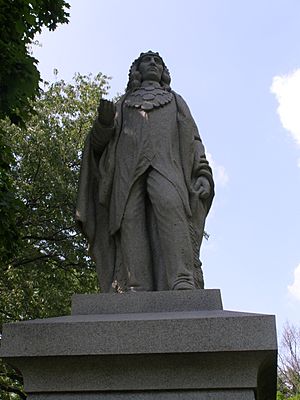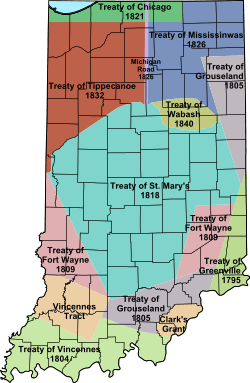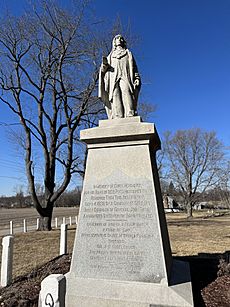Chief Menominee facts for kids
Quick facts for kids
Chief Menominee
|
|
|---|---|

Menominee Statue, Plymouth, Indiana
|
|
| Born | c. 1791 |
| Died | April 15, 1841 |
| Nationality | Pottawatomie |
| Occupation | Pottawatomie chieftain |
| Known for | Pottawatomie chieftain during the Trail of Death |
Menominee (born around 1791 – died April 15, 1841) was an important Potawatomi chief and spiritual leader. His village was located near Twin Lakes, Indiana, about 5 miles (8.0 km) southwest of Plymouth, Indiana. This village became a gathering place for Potawatomi people who did not want to leave their lands in Indiana in 1838.
Even though Menominee's name was on some land agreements, he and other Potawatomi leaders refused to join later talks. These talks led to the forced removal of his group from Indiana in 1838. This difficult journey is known as the Potawatomi Trail of Death.
Menominee was one of 859 Potawatomi people forced to move from Twin Lakes, Indiana, to lands in Kansas. The journey lasted 61 days, from September 4 to November 4, 1838. They traveled about 660 miles (1,060 km). Sadly, 42 people died along the way, including 28 children. This was the largest forced removal of Native Americans from Indiana.
Menominee survived the march to Kansas. He died less than three years later and was buried at St. Mary's Mission, Kansas. In 1909, the State of Indiana built a statue of him. It stands near the Yellow River, close to his old village. This was the first monument to a Native American built by a state or federal law.
Contents
Who Was Chief Menominee?
Menominee was a Potawatomi Native American. We do not know his exact birth date or place. It is thought he was born around 1791, possibly in Wisconsin or Indiana. The Potawatomi spoke an Algonquian language. They became the second largest Native American group in Indiana.
They moved south from northern Wisconsin and Michigan. Their lands covered a large area. This included the southern tip of Lake Michigan to Lake Erie. It also included northern Illinois, north central Indiana, and part of southern Michigan.
Menominee's Village and Land
Over time, the U.S. government made many land agreements with Native American tribes. These agreements, called treaties, meant tribes had to give up most of their lands. This happened in Illinois and Indiana.
Menominee and his group built a village on their land. It was near the start of the Yellow River. This area was close to Twin Lakes, Indiana, southwest of Plymouth, Indiana. It is now in Marshall County, Indiana.
Menominee's Spiritual Beliefs
Menominee became a spiritual leader. People called him the "Potawatomi Preacher" or "Potawatomi Prophet." He was not as famous as Tenskwatawa, a Shawnee spiritual leader. Menominee combined some of Tenskwatawa's ideas with Roman Catholicism.
He created a new religion. This helped his people deal with changes. Settlers were moving onto their lands. The government wanted the Potawatomi to give up their lands and move west. Menominee encouraged prayer in his gatherings. He also told the Potawatomi to avoid alcohol.
Menominee welcomed other religious groups to northern Indiana. In 1820, he invited Isaac McCoy, a Baptist missionary, to visit his villages. Later, a Catholic mission was set up near the Potawatomi community in Niles, Michigan.
In 1834, Father Louis Deseille expanded the Catholic mission. He brought it to Menominee's village at Twin Lakes. These two communities strongly resisted being removed from their lands. Father Deseille baptized Menominee on August 24, 1834. Menominee was given the Christian name Alexis.
The Indian Removal Act
 |
|
|---|---|
| Type | Land purchase |
| Signed | October 26, 1832 |
| Location | Near Rochester, Indiana |
| Condition | Transfer of money and goods to natives |
| Parties | |
| Language | English |
In 1830, the United States Congress passed the Indian Removal Act. This law gave the government power to get Native American lands in the eastern states. In return, tribes would get lands west of the Mississippi River. They would also keep their tribal status. After this law, the government worked harder to get Native American lands in the East.
From 1832 to 1840, the Potawatomi gave up many parts of their Indiana land. Menominee's name is on two of these treaties. These are the Treaty of Tippecanoe (October 26, 1832) and a treaty signed on December 16, 1834.
Menominee's mark, an "x", was on the Treaty of Tippecanoe (1832). This treaty gave the government Potawatomi land in Illinois, most of their remaining land in Indiana, and part of Michigan. In exchange, the Potawatomi received payments and small areas of land for their use. They also got help for moving if they chose to relocate.
This treaty also gave Menominee's group and others 22 sections of land (about 14,080 acres). This land was in the Yellow River area. Menominee also signed a treaty on December 16, 1834. This treaty gave up two sections of their Indiana land. However, he refused to sign any more treaties that would give away his Indiana lands.
Refusal to Leave
The Treaty of Yellow River (1836) led directly to Menominee's group being forced to move. This treaty was made on August 5, 1836. Menominee and 17 others from the Yellow River group did not take part in these talks. They refused to accept the treaty's power over their land.
Under this treaty, the Potawatomi who signed it gave up all the land they received in the 1832 Treaty of Tippecanoe. They also agreed to move west of the Mississippi River within two years. This was in exchange for selling their Indiana lands and paying tribal debts.
Menominee's name is on a treaty from December 16, 1834. But this treaty does not mention moving west of the Mississippi River. More importantly, Menominee did not sign a key treaty on February 11, 1837. In this treaty, others agreed to move to land in Kansas.
In November 1837, Menominee and other Potawatomi sent a formal complaint. They said their signatures on the August 5, 1836, Yellow River treaty were fake. They also said names of people who did not represent the tribe were added. There is no record of a reply to this complaint. Other complaints were sent to President Martin Van Buren and Secretary of War Lewis Cass. But the government would not change its mind.
Father Deseille, a Catholic missionary at Twin Lakes, also said the Yellow River Treaty (1836) was a fraud. The government's treaty negotiator, Col. Pepper, believed Father Deseille was stopping their plans. He ordered the priest to leave the mission. Father Deseille left and died in September 1837. Father Benjamin Petit took his place in November 1837. After a few months, Father Petit also accepted that the Potawatomi would be removed.
Rising Tensions and Forced Removal
Tensions grew between the Potawatomi and white settlers in the 1830s. The government planned to open the Potawatomi lands for new settlements. People who wanted land quickly moved onto the best parts of the reservation. This left the Potawatomi surrounded by white settlements.
A solution was found, but it did not stop the tension. Potawatomi who had agreed to leave Indiana arrived at government camps. These camps were near Menominee’s village at Twin Lakes. They were preparing to move west. But Menominee’s village became a meeting place for those who refused to go.
The deadline for Menominee and his group to leave Indiana was August 5, 1838. Most Potawatomi had already left the state. But Menominee's group still refused to leave their village. On August 6, 1838, Col. Pepper held a meeting at Menominee's village. He explained that the Potawatomi had given up their land through treaties. The land now belonged to the government, and the Potawatomi had to move.
Menominee replied through an interpreter: "The President does not know the truth. He, like me, has been imposed upon. [...] He would not drive me from my home and the graves of my tribe, and my children, who have gone to the Great Spirit, nor allow you to tell me your braves will take me, tied like a dog, if he knew the truth. My brother, the President is just, but he listens to the word of young chiefs who have lied; and when he knows the truth, he will leave me to my own. I have not sold my lands. I will not sell them. I have not signed any treaty, and will not sign any. I am not going to leave my lands, and I do not want to hear anything more about it."
Despite Menominee's refusal, white settlers kept coming to the Potawatomi land. Conflicts started. The Potawatomi destroyed the settlers' huts. The white settlers fought back by burning some of the Native American cabins. People feared more violence. Some settlers asked Indiana governor David Wallace for protection.
Governor Wallace told General John Tipton to gather a local group of one hundred volunteers. Their job was to stop the conflict. They were also to force the Potawatomi from their Indiana lands. This forced march became known as the Potawatomi Trail of Death. It was the largest forced removal of Native Americans in Indiana.
On August 29, 1838, General Tipton and his volunteers arrived. They surrounded Menominee's village at Twin Lakes. A meeting was held at the village chapel. There, the militia took the Potawatomi chiefs, including Menominee, into custody. From August 30 to September 3, 1838, Tipton and his men prepared for the removal. They gathered the Potawatomi still living on the reservation.
The Trail of Death
Menominee and his Yellow River group were among 859 Potawatomi forced to march from Twin Lakes, Indiana, to Osawatomie, Kansas. Many of them were Christian. The difficult journey began on September 4, 1838. It covered about 660 miles (1,060 km) over 61 days. The group also had 286 horses, 26 wagons, and 100 soldiers guarding them.
In the first days, six chiefs, including Menominee, were treated as prisoners. They were forced to ride in a wagon under armed guard. Father Petit, who joined his people on the march, got them released from the wagon. He promised they would not try to escape.
Water was hard to find along much of the trail. The food given by the government was so bad that the soldiers refused to eat it. They demanded money to buy their own food. As the march went through Indiana and Illinois, a typhoid sickness spread. More than three hundred people became sick.
Of the 859 who started the journey, Menominee was among the 756 Potawatomi who survived. Forty-two people died, and others escaped. The Potawatomi reached their destination in Kansas on November 4, 1838. They were placed under the care of a local Indian agent and Reverend Christian Hoecken.
In 1839, Menominee and his group moved about 20 miles (32 km) south to the Sugar Creek mission in Linn County, Kansas. Menominee died on April 15, 1841. He is buried at St. Mary's Mission, Kansas.
Honors and Legacy
In 1909, the State of Indiana built a statue of Chief Menominee. It is near the start of the Yellow River, about 3 miles (4.8 km) southwest of Plymouth, Indiana. This was the first monument to a Native American built because of a state or federal law. The Chief Menominee Memorial Site was added to the National Register of Historic Places in 2010.
See also


